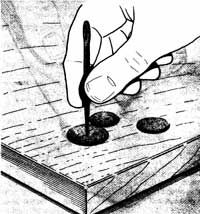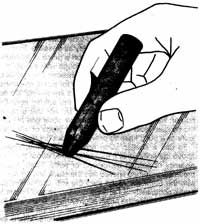How to Repair Furniture Scratches, Dings, and Dents
Old or new, wooden furniture often shows signs of extensive use: scratches, dings, and dents. Most of these surface damages are easy to repair, unless the problem is severe and extensive.
Scratches
To hide small scratches quickly, break the meat of a walnut, pecan, or Brazil nut and rub it along the scratch. The oil in the nut meat will darken the raw scratch.
Advertisement
Where many shallow scratches are present, apply hard paste wax to the surface with No. 0000 steel wool, stroking very lightly along the grain of the wood. Then buff the surface with a soft cloth. For shallow scratches on an otherwise sound shellac or lacquer finish, reamalgamation can be used to restore the finish.
For one or two deeper scratches, furniture-patching wax sticks are usually effective. These retouching sticks, made in several wood colors, are available at hardware and sometimes grocery stores. Choose a stick to match the finish. To use the wax stick, run it firmly along the scratch, applying enough pressure to fill the scratch with wax. Remove any excess wax with the edge of a credit card or other thin plastic card. Let the wax dry; then buff with a soft cloth.
Badly scratched surfaces should usually be re-finished, but to hide one or two very deep scratches, you may be able to stain the raw area to match. Apply oil-based stain with an artists' brush, drawing it carefully along the scratch; let it stand for 15 minutes and wipe it off. If necessary, repeat this procedure until the scratch matches the rest of the wood.
Let the area dry completely, as directed by the stain manufacturer. Then apply hard paste wax and buff the waxed surface to a shine.
Dings
Dings are tiny chips in the finish, usually caused by a sharp blow. The wood may not be affected. To repair a ding, use a sharp craft knife to remove any loose finish in or around the ding. Work carefully, scraping the damaged spot with the flat, sharp edge of the knife blade; do not scratch the spot. Then very carefully feather the edges of the ding with No. 0000 steel wool.
Clean the ding area with a soft cloth moistened in mineral spirits, and let it dry completely. Then, with an artists' brush, carefully apply new finish to the spot -- varnish, shellac, lacquer, or enamel -- to match the rest of the finish. The spot will be very noticeable at first. Let the finish dry; it will be glossy. Then lightly buff the spot with No. 0000 steel wool, and wax and polish the entire piece of furniture. The ding should blend perfectly when the job is complete.
Dents
Small, shallow dents in pine and other soft woods are usually easy to remove; large and deep dents, especially in hard wood, are harder to repair. Dents are easiest to remove from bare wood. Very large, shallow dents are probably best left untreated. Very deep dents should be filled, as detailed below for cracks and gouges.

On finished surfaces, you'll have to remove the finish around the damaged area. Using fine-grit sandpaper, carefully remove the finish for about 1/2 inch around the spot. To raise the wood in the dent, apply a few drops of water to the dent and let the water penetrate the wood for a day or so. Do not wet the entire surface. This treatment may be enough to raise the dent, especially if the dent is shallow and the wood is soft.
If this doesn't raise the dent, soak a cloth in water and wring it out. Place the damp cloth, folded in several layers, over the dent; then press the cloth firmly with a warm iron.
Be careful not to touch the iron directly to the wood. This moist heat may be enough to swell the wood and raise the dent. If it isn't, apply a commercial wood-swelling liquid to the area and give it time to work -- about a day or so, as directed by the manufacturer.
For deep dents that can't be raised with water, heat, or wood sweller, use a fine straight pin or needle to drive a series of holes in the dent. Pound the straight pin in about 1/4 inch, and carefully pull it out with pliers; the holes should be as small as possible. Then treat the dent you would for a shallow dent. The pinholes let the water penetrate the wood's surface. If you're careful, the holes won't show when the wood has been raised.
After the dent has been raised, let the wood dry for about a week, and then refinish the damaged area as above. Let the finish dry completely. Lightly buff the new finish with No. 0000 steel wool, and then wax and polish the entire surface.
Deeper cracks and gouges in the surface may require additional work. Learn the basic steps to repair cracks and gouges on wooden furniture in the next section.
